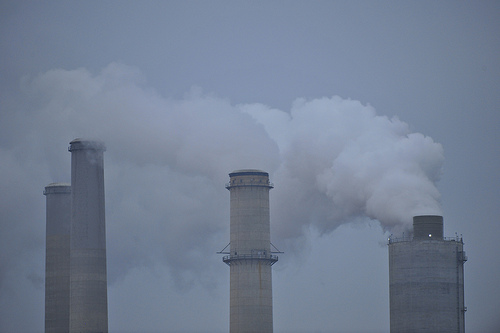
The Lower Rio Grande Valley Sierra Club ran the numbers, and the four proposed Brownsville LNG export terminals will produce as much nitrogen oxides annually as all the vehicles on the road in Cameron County. Find out what other pollutants the natural gas export facilities could bring to the Valley in this column by Sierran Stefanie Herweck.
(Originally published in the Rio Grande Guardian on July 20) The first thing you notice are the roiling orange flames spewing out of slender pipes, creating a black smoke that dilutes into the brownish air above.
Tall, soot-covered silos shoot skyward out of a maze of dirty pipes. In the foreground, squat tanks are marked with rust stains and posted with warning signs which you can just make out. There’s an acrid, chemical smell in the air, and your breathing instinctively becomes shallow.
You’re in Beaumont. You’re in Port Arthur. You’re near the Houston Ship Channel. Or you’re driving through Corpus Christi. And you’re trying to get out of there—to get past the unhealthy industrial hellscape of petrochemical plants as soon as you can.
If you’ve traveled through Texas’ other coastal cities, you’ve had this experience. And if you’re like me, you probably thought to yourself, thank God I don’t live here.
Unfortunately, petrochemical plants like these could be coming to us here in the Valley. The Brownsville Navigation District has leased land for four liquefied natural gas (LNG) export terminals which are now awaiting permits. A fifth lease is reportedly in the works.
The terminals proposed for the Port of Brownsville would first remove impurities from the gas and then supercool it to minus 260 degrees Fahrenheit, so that it liquefies and condenses to 1/600th of its volume. The liquefied gas can then be loaded onto tanker ships bound for Europe and Asia.
These refining and refrigeration processes release harmful emissions that will pollute our air and water and put our most vulnerable populations—children and the elderly—at risk.
Although none of the LNG companies coming to the Port of Brownsville have released estimates of their expected emissions, we can calculate rough amounts of the pollutants they will emit by comparing them to a recent report on the expansion of Louisiana’s Sabine Pass LNG facility. Sabine Pass LNG’s expansion will allow it to process 1.4 billion cubic feet per day. Together, the four Brownsville LNG facilities awaiting permits have stated that they will process 5.6 billion cubic feet per day.
Sabine Pass LNG reports that with its expansion in place it will produce 1,820.83 tons per year of nitrogen oxides (NOx). If we assume similar emission rates for the Brownsville LNG projects, we can expect 7,296.33 tons per year of nitrogen oxides. Nitrogen oxides make up the poisonous “brown cloud” that you see in large cities like Houston. They worsen asthma symptoms and damage lungs. They also contribute to acid rain and harm marine life. The amount the Brownsville facilities will emit is approximately equivalent to the total NOx emissions produced annually by all the vehicles in Cameron County.
Sulfur dioxide (SO2) is another contributor to acid rain, and the refineries can be expected to emit more than 24 tons per year, a nine percent increase in the total Cameron County emissions of SO2.
Based on the Sabine Pass LNG expansion, the four LNG projects at the Port of Brownsville can also be expected to emit 362 tons per year of volatile organic compounds (VOCs), which are chemicals that contribute to smog and pollute water. Some, like benzene and toluene, are carcinogens. Indeed, a possible cancer cluster being investigated in the Barnett Shale region of north Texas has been linked to benzene emissions from nearby natural gas drilling.
Carbon monoxide (CO) is a poison produced when fossil fuels do not burn completely. It can be particularly harmful to pregnant women, fetuses and babies, and people with heart conditions. Using the Sabine Pass expansion as a guide, we can estimate that the Port of Brownsville operations will add 11,222 tons per year of carbon monoxide, an approximately 20 percent increase in Cameron County’s total annual CO emissions.
We can also expect the proposed LNG plants to emit 455 tons per year of particulate pollution, consisting of particles small enough to be inhaled. These cause respiratory problems and aggravate heart problems. Children and the elderly are especially vulnerable to particulates.
The Port of Brownsville’s LNG refineries will also pump out an estimated 10.1 million tons of greenhouse gas (GHG) emissions. To put that in perspective, the EPA lists only two large-facility sources of GHG in Cameron County, the Silas Ray Power Plant and the Municipal Waste Dump. Together they produced 130, 815 tons of GHG in 2012. As a region that is on track to suffer potentially catastrophic impacts of drought, stronger storms and sea level rise from global warming, we should work to minimize, not supersize, our carbon footprint.
Politicians like Congressmen Vela and Cuellar have called LNG a windfall for the Rio Grande Valley. What they don’t talk about are the toxins that that wind will bring.
Instead of silently accepting their LNG sales pitch, we need to speak up and initiate a community conversation about what the coming of LNG could mean. Are we ready for the smoky flares and the brown clouds? Are we comfortable living and raising our children where poisons and carcinogens blow in the wind? Are we really willing to sacrifice our clean air and water?
It’s a momentous decision that we should all be involved in.
Stefanie Herweck is on the executive committee of the Lower Rio Grande Valley Sierra Club. She lives in McAllen.